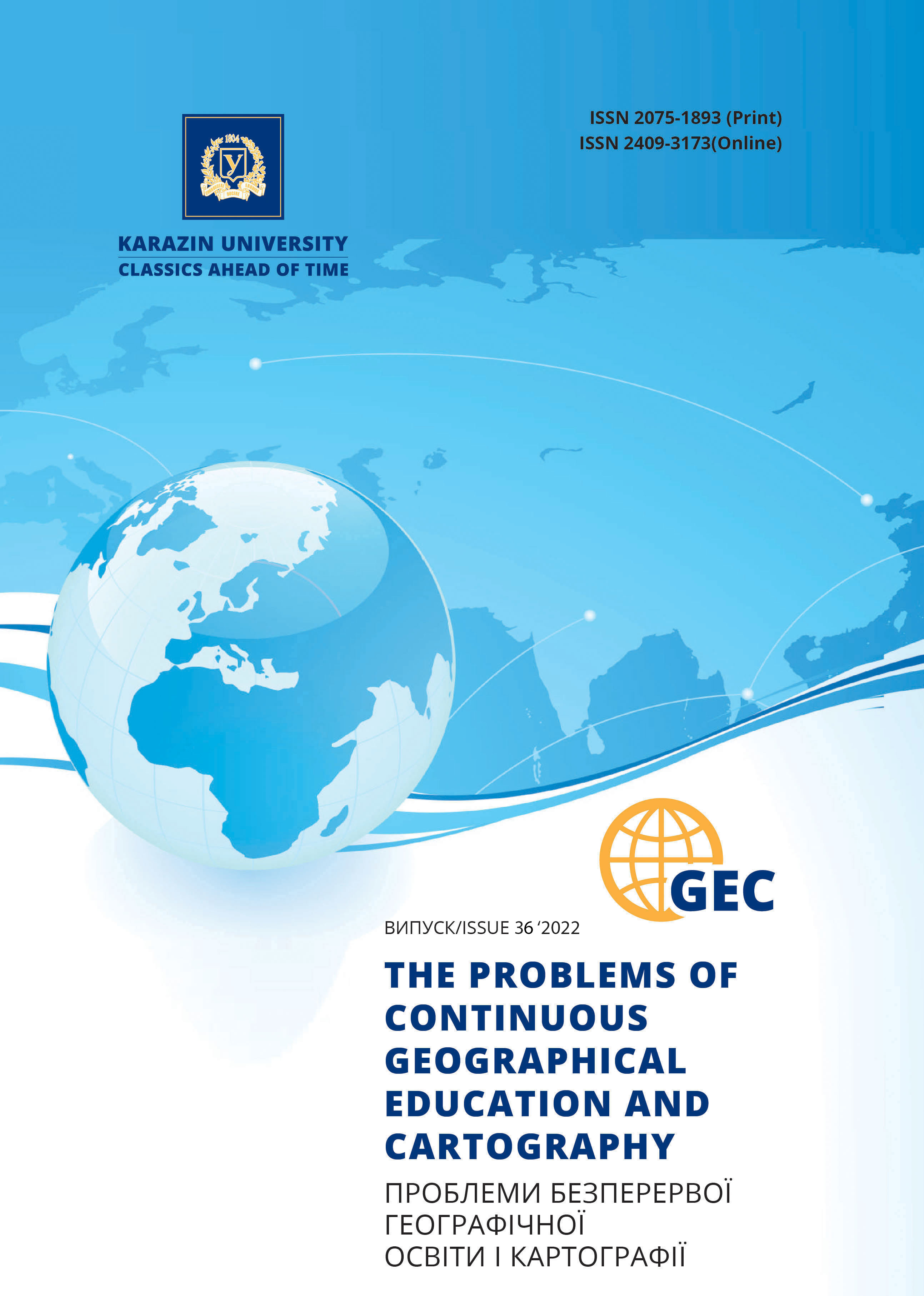Distance learning technology in teaching geography course of continents and oceans in secondary general-education schools
Abstract
The purpose of this article. The purpose of the article is to highlight the possibilities and prospects of involving distance- learning technology in teaching geography course of continents and oceans in Ukrainian secondary general-education schools.
The main material. The article considers the essence, use of theoretical and methodological principles of distance educational technologies in secondary general-education schools of Ukraine, including didactic principles of their application, approaches to the interpretation of the essence of the informational educational environment. The study highlights practical aspects of implementing the distance learning technology in teaching geography of 7th grade, characterizing the use of interactive and cloud services in geography, showing the advantages and disadvantages of implementing the distance learning technology in teaching geography course of continents and oceans.
We interpret the term” distance learning technology” as a set of educational content for teaching and learning as well as a number of pedagogical and technological methods/technologies allowing us to implement the remote learning in synchronous or asynchronous modes. The educational environment includes informational (educational) content, control/ correction’ content of study material; informational and reference content, etc. We use Bloom’s modified taxonomy as a conceptual foundation to implement distance - learning technology. Based on it, we should develop the tools for controlling knowledge and skills as well as monitor the effectiveness of these knowledge/skills assimilation.
When teaching geography in the 7th grade, it is recommended to use both adapted versions of “classical” pedagogical methods, in particular case technologies, flipped classroom technologies, mixed learning technologies, as well as the closest to distance learning - TV and network technologies, widely used in Ukraine since March 2020 p. The most common in Ukraine is the synchronous teaching format, which means conducting lessons in real time by using video conferences on ZOOM, Google Meet, WebEx platforms. On the other hand, the asynchronous format, which means the distance- learning course development by teachers, is not so popular due to insufficiently formed digital and information-communication competences of the majority of teachers. Because of this, it is difficult for teachers to master online tools of a modern teacher, in particular, eTreniki, Learningapps, and WWW services.
Interactive network services such as the Seterra portal, the Geoguessr map service, the National Geographic service, the Barefoot World Atlas portal, provide many opportunities for the teacher during distance learning implementation, for example, interesting game tasks for learning the nomenclature, the ability to “float” around a 3D globe, etc. The use of cloud-based services, in particular Office365 and G Suite for Education (Google WorkSpace), allows teachers to systematize educational content and automate the verification of test tasks.
The advantages of implementing the distance learning technology in teaching geography include supporting the educational process in emergency, increasing both individualization of learning, and the visibility in the teaching process. Disadvantages are the difficulty of perceiving the material by some students, dependence of the quality of learning on external conditions - availability of power supply, the Internet, modern gadgets.
Conclusions and further research. Distance learning technology allows us to organize the remote (distant) learning, which is very important for continuing the educational process during a pandemic, martial law, or other situations when students cannot attend school. The teachers use mixed learning technologies, TV and network technologies in teaching geography in the 7th grade. The most common is synchronous learning, represented by online communication between the teacher and students in real time with video conferences, using ZOOM, Google Meet, WebEx, etc. services.
The largest range of possibilities for teaching the course “Geography of Continents and Oceans” includes interactive online geography services, such as the Seterra portal, the Geoguessr cartographic service, Google maps, interactive online atlases, in particular the Barefoot World Atlas. Cloud services, in particular Office365 and G Suite for Education (oogle WorkSpace), include the availability of educational content in the form of presentations, textual, illustrative and other materials to be used during a distance lesson, as well as a set of online tools for a modern teacher. However, the majority of teachers have a low level of digital competence and cannot master them efficiently.
When conducting distance geography lessons in the 7th grade, teachers should use tools for working with an interactive map (currently, these opportunities are very little used). When working with tools for making control tasks for students, the teachers should use the possibility of including photos and map images. The virtual whiteboard, which is a component of programs for conducting video conferences, allows teachers to organize work on the project in mini-groups.
The prospective direction of our research is to keep working on studying the possibilities to implement Smart-education based on distance learning technology, which will contribute to formation of a Smart-society in Ukraine.
Downloads
References
Bubyr, N.,O., Lavrenova, S.M. (2021). Approaches to formation of information educational environment for teaching geography of continents and oceans in Ukrainian secondary general-education schools. Proceedings of VI International Scientific and Practical Conference “European scientific discussions” April 25-27, Rome, Italy, 217–222 [in Ukrainian].
Acquiring knowledge. Remote support of schoolchildren’s education. Available at: https://disted.edu.vn.ua/courses/work/143 [in Ukrainian].
Advantages of distance education in Ukraine. available at : http://www.forest.lviv.ua/statti/distance.html [in Ukrainian].
Taylor, J.C. (2002). Distance education technologies: The fourth generation. The fourth generation. Australian Journal of Educational Technology, 11, 4–17 [in English].
Doucet, A., Netolicky, D., Timmers, K., Tuscano, F.J. (2020). Thinking about Pedagogy in an Unfolding Pandemic. Available at: https:// issuu.com/educationinternational/docs/2020_research_covid-19_eng [in English].
Seydaghaee, F. (2007). Special Issue of Payame Noor University. Iran Newspaper, 13 [in English].

This work is licensed under a Creative Commons Attribution 4.0 International License.





